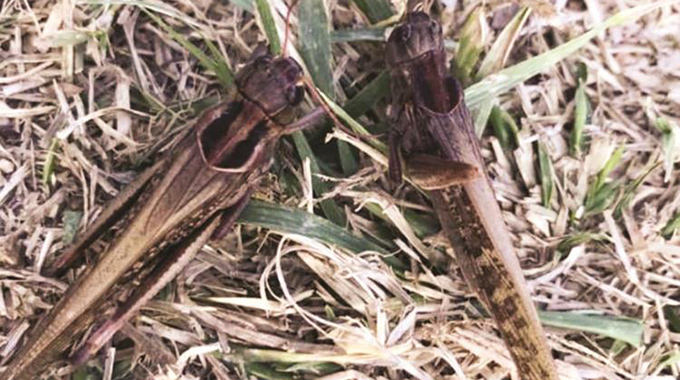
East Africa is in the midst of a Book of Exodus-kind-of-crisis with a plague of locusts spreading across the region threatening food supply systems and livelihoods for millions of people. The scale of the locust outbreak has been described as the worst in living memory. In Zimbabwe, a recent outbreak of the African migratory locust at the Gonarezhou National Park is sending jitters over swarms of the dreaded pests which have a potential of wreaking havoc in the coming 2020–2021 cropping season. In this report, Sifelani Tsiko (ST), our Agric, Environment & Innovations Editor speaks to Shingirai Nyamutukwa (SN), head of the Plant Quarantine & Plant Protection Research Services Institute of the ministry of agriculture on the latest locust attack in the southern part of the country.

The local African migratory locusts
ST: When exactly did you first get an alert over the swarms which were reported to have been seen at Gonarezhou National Park?
SN: First reports came from our Agritex officer in Chiredzi on June 23, who reported about the sightings of locusts in Chiredzi rural district. However, when I spoke to an ecologist from Malilangwe conservancy, he told us that the locusts were first sighted within Malilangwe Wildlife Reserve on June 16 having entered the area from Chizvirizvi resettlement area, east of Malilangwe. The swarm of locusts left on June 17 and were later sighted about 25km north-east in the Sangwe communal area near Save River.
ST: Where do you think are the breeding grounds for these locusts?
SN: The breeding grounds are in multiple locations in the Lowveld areas that include Chisumbanje, Chiredzi, conservancies around Chiredzi, as well as the Gonarezhou National Park.
ST: What is the type of the locusts that were spotted at Gonarezhou National Park?
SN: There are about four types of locusts that pose a serious threat to crops. The ones reported in Zimbabwe are what we call the local African migratory locusts. These have also been reported in Botswana, Zambia and Namibia. These are indigenous species. However, we also experience invasions from another second type known as the red locust which affected Zimbabwe in July 2008. We also have the Desert locusts that are being reported in Kenya and other six East African countries. The brown locusts is another type of locust that has also been reported in other parts of the world. Here in Zimbabwe, we mainly record the African migratory locust outbreaks. These are indigenous locust populations that build up into swarms, leading to outbreaks.
ST: What combative strategies did the Plant Protection Research Institute take to fight the locust swarm? Which specific areas are you working in to fight the locusts?
SN: Our Plant Quarantine & Plant Protection Research Services Institute had chemicals ready and which were delivered to the Chiredzi Research Station for use by farmers. However, the locusts never spend long periods of time at one place. They migrated north-west towards Manjirenji Dam and to the south-east of Mkwasine on June 25. Raising awareness among local communities has been key. This has helped local farmers to scout for the swarms. The locusts are a delicacy, so farmers harvested them for consumption, something which becomes a challenge when you bring chemicals for pest control.
ST: Can this be described as a locust outbreak? If not, explain to us the nature of the swarms and what it takes to have a locust outbreak.
SN: This is a locust outbreak. This is not regular pest. When you have unusually high locust populations building up into large swarms, then that’s an outbreak. The last African migratory locust outbreak was in 2007, from the records I have.
ST: Have you conducted any local community awareness campaigns in the affected areas?
SN: Yes, we have done awareness campaigns. During these campaigns we have been requesting farmers to scout and report swarms to the nearest Department of Research and Specialist Services staff, Agritex and the police. We also informed them that they could access chemicals which we could deliver to them closer to outbreak areas should situation get out of hand.
ST: What action have you taken to destroy the swarms you have found?
SN: Farmers have been the first to reach the swarms for harvesting. Any control with chemicals was therefore compromised. But chemicals would be effective if locusts were far from human habitable areas. So, we had to be cautious not to affect the public health of local communities.
ST: What are some of challenges you are facing when it comes to tracking, monitoring and fighting the swarms in the affected areas? What are the major requirements that can enable you to carry out control and prevention programmes?
SN: The main challenge we are facing is lack of fuel to enable us to effectively track the swarms of locusts. Due to lack of fuel, at times we had to rely on extension officers and farmers’ information in tracking the locusts. Cellular communication costs also impacted on our efficiency to get accurate information from extension officers and farmers. Having vehicles that can traverse all terrains even where there are no proper roads could assist us in better tracking and carrying out surveillance. Equipment such as mist-blowers can come in quite handy for control, especially in breeding areas at hopper stage before swarms fly.
ST: Briefly tell us some of the key periods in history that Zimbabwe experienced major locust plagues?
SN: Zimbabwe has witnessed several episodes of the scourge of locust plagues over the last century and the ones that come to mind and were over the last decade, include the African migratory locust outbreaks which were experienced in the 2006-7 cropping season. For red locusts, 2008 was our last invasion.
ST: What do you think needs to be done to prevent a major outbreak before the main 20/21 cropping season starts from around October this year?
SN: We need to continue monitoring the current swarms and breeding areas for possible secondary outbreaks, as these adult ones are likely to breed and cause more locust outbreaks. We need to be alert and fund various strategies we may adopt to control the current swarms before it’s too late.
ST: Are you getting any major help from some international organisations such as the UN Food and Agriculture Organisation or the International Red Locust Control Organisation for Central and Southern Africa (IRLCO-CSA)? If yes, can you briefly tell us about the nature of the assistance.
SN: We always get assistance from IRLCO-CSA, FAO, SADC and this time around we hope the World Bank and AfDB may also assist in dealing with the migratory pests. Assistance is usually in the form of gadgets and equipment we use to conduct surveillance and forecasting of outbreaks of migrant pests. We use such equipment to also do regional controls of locusts in their breeding grounds, especially red locusts so that they do not invade other territories. Capacity building, including training, as well as technical support is also provided by these organisations, including awareness materials and updates on migrant pests.
